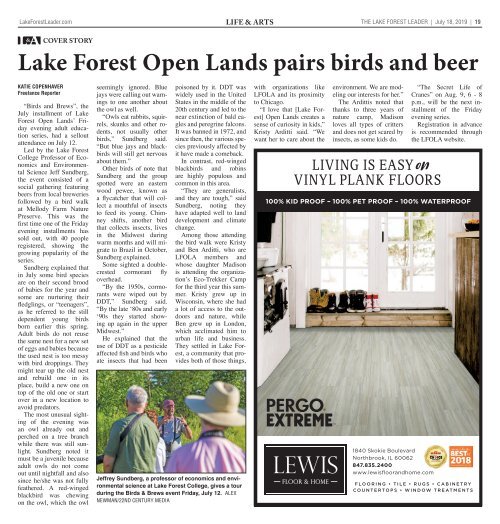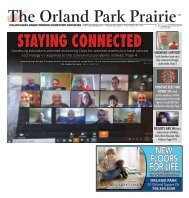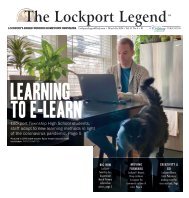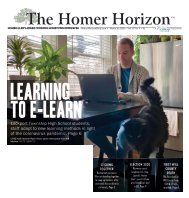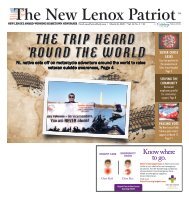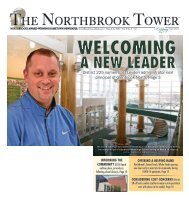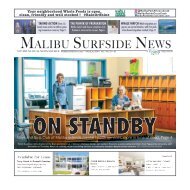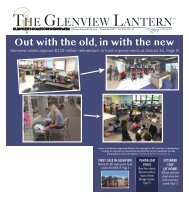LF_071819
LF_071819
LF_071819
Create successful ePaper yourself
Turn your PDF publications into a flip-book with our unique Google optimized e-Paper software.
LakeForestLeader.com life & arts<br />
the lake forest leader | July 18, 2019 | 19<br />
Lake Forest Open Lands pairs birds and beer<br />
Katie Copenhaver<br />
Freelance Reporter<br />
“Birds and Brews”, the<br />
July installment of Lake<br />
Forest Open Lands’ Friday<br />
evening adult education<br />
series, had a sellout<br />
attendance on July 12.<br />
Led by the Lake Forest<br />
College Professor of Economics<br />
and Environmental<br />
Science Jeff Sundberg,<br />
the event consisted of a<br />
social gathering featuring<br />
beers from local breweries<br />
followed by a bird walk<br />
at Mellody Farm Nature<br />
Preserve. This was the<br />
first time one of the Friday<br />
evening installments has<br />
sold out, with 40 people<br />
registered, showing the<br />
growing popularity of the<br />
series.<br />
Sundberg explained that<br />
in July some bird species<br />
are on their second brood<br />
of babies for the year and<br />
some are nurturing their<br />
fledglings, or “teenagers”,<br />
as he referred to the still<br />
dependent young birds<br />
born earlier this spring.<br />
Adult birds do not reuse<br />
the same nest for a new set<br />
of eggs and babies because<br />
the used nest is too messy<br />
with bird droppings. They<br />
might tear up the old nest<br />
and rebuild one in its<br />
place, build a new one on<br />
top of the old one or start<br />
over in a new location to<br />
avoid predators.<br />
The most unusual sighting<br />
of the evening was<br />
an owl already out and<br />
perched on a tree branch<br />
while there was still sunlight.<br />
Sundberg noted it<br />
must be a juvenile because<br />
adult owls do not come<br />
out until nightfall and also<br />
since he/she was not fully<br />
feathered. A red-winged<br />
blackbird was chewing<br />
on the owl, which the owl<br />
seemingly ignored. Blue<br />
jays were calling out warnings<br />
to one another about<br />
the owl as well.<br />
“Owls eat rabbits, squirrels,<br />
skunks and other rodents,<br />
not usually other<br />
birds,” Sundberg said.<br />
“But blue jays and blackbirds<br />
will still get nervous<br />
about them.”<br />
Other birds of note that<br />
Sundberg and the group<br />
spotted were an eastern<br />
wood pewee, known as<br />
a flycatcher that will collect<br />
a mouthful of insects<br />
to feed its young. Chimney<br />
shifts, another bird<br />
that collects insects, lives<br />
in the Midwest during<br />
warm months and will migrate<br />
to Brazil in October,<br />
Sundberg explained.<br />
Some sighted a doublecrested<br />
cormorant fly<br />
overhead.<br />
“By the 1950s, cormorants<br />
were wiped out by<br />
DDT,” Sundberg said.<br />
“By the late ‘80s and early<br />
‘90s they started showing<br />
up again in the upper<br />
Midwest.”<br />
He explained that the<br />
use of DDT as a pesticide<br />
affected fish and birds who<br />
ate insects that had been<br />
poisoned by it. DDT was<br />
widely used in the United<br />
States in the middle of the<br />
20th century and led to the<br />
near extinction of bald eagles<br />
and peregrine falcons.<br />
It was banned in 1972, and<br />
since then, the various species<br />
previously affected by<br />
it have made a comeback.<br />
In contrast, red-winged<br />
blackbirds and robins<br />
are highly populous and<br />
common in this area.<br />
“They are generalists,<br />
and they are tough,” said<br />
Sundberg, noting they<br />
have adapted well to land<br />
development and climate<br />
change.<br />
Among those attending<br />
the bird walk were Kristy<br />
and Ben Arditti, who are<br />
<strong>LF</strong>OLA members and<br />
whose daughter Madison<br />
is attending the organization’s<br />
Eco-Trekker Camp<br />
for the third year this summer.<br />
Kristy grew up in<br />
Wisconsin, where she had<br />
a lot of access to the outdoors<br />
and nature, while<br />
Ben grew up in London,<br />
which acclimated him to<br />
urban life and business.<br />
They settled in Lake Forest,<br />
a community that provides<br />
both of those things,<br />
Jeffrey Sundberg, a professor of economics and environmental<br />
science at Lake Forest College, gives a tour<br />
during the Birds & Brews event Friday, July 12. ALEX<br />
NEWMAN/22ND CENTURY MEDIA<br />
with organizations like<br />
<strong>LF</strong>OLA and its proximity<br />
to Chicago.<br />
“I love that [Lake Forest]<br />
Open Lands creates a<br />
sense of curiosity in kids,”<br />
Kristy Arditti said. “We<br />
want her to care about the<br />
environment. We are modeling<br />
our interests for her.”<br />
The Ardittis noted that<br />
thanks to three years of<br />
nature camp, Madison<br />
loves all types of critters<br />
and does not get scared by<br />
insects, as some kids do.<br />
LIVING IS EASY<br />
VINYL PLANK FLOORS<br />
100% KID PROOF – 100% PET PROOF – 100% WATERPROOF<br />
1840 Skokie Boulevard<br />
Northbrook, IL 60062<br />
847.835.2400<br />
www.lewisfloorandhome.com<br />
“The Secret Life of<br />
Cranes” on Aug. 9, 6 - 8<br />
p.m., will be the next installment<br />
of the Friday<br />
evening series.<br />
Registration in advance<br />
is recommended through<br />
the <strong>LF</strong>OLA website.<br />
FLOORING • TILE • RUGS • CABINETRY<br />
COUNTERTOPS • WINDOW TREATMENTS


